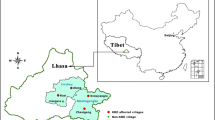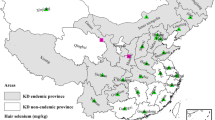Abstract
The focus of this study is to determine the relationship between selenium (Se) concentrations in child hair and the distribution of Kashin-Beck disease (KBD) in Tibet. The hair of children in typical KBD-affected areas and non-disease areas was collected, and its Se concentrations were measured by atomic fluorescent spectrometry. The Se concentrations in child hair were (0.13±0.04) and (0.18±0.07) μg/g respectively in KBD areas and non-disease areas respectively, which are significantly different. In areas supplemented with Se in Tibet, the Se concentration of hair in KBD-affected areas was higher than that in non-diseased areas, being (0.28±0.03) and (0.18±0.04) μg/g respectively. There is a close relationship between the Se concentrations in hair and KBD distribution. Se supplement increase the Se concentrations in the human body. Appropriate Se supplementation is important to prevent KBD in Tibet.
Similar content being viewed by others
References
The Group of Environment and Endemic Disease. The characteristics of geographical epidemiology for Kashin-Beck disease in China and its pathogenicity. Scientia Geographica Sinica, 1985, 5(1): 1–8 (in Chinese)
Xirao R D. The present status of Kaschin-Beck disease distribution in Tibet. Chin J Endemiol, 1999, 14(2): 115–116 (in Chinese)
Bai S, Lu S M, Wang Z L, Xue L, Lei Y X. Determinations of hair copper, Zinc, Manganese and Iron contents in children from a Kaschin-Beck disease (KBD) areas and non-KBD areas with normal and low hair selenium contents. Endemic Diseases Bulletin, 1995, 10(1): 4–6 (in Chinese)
Deng J Y, Li D Y, Cai W, Zhu L, Liang D H, Gu Y, Ma G J, Xu Q L, Wang Y G, Ze H, Chang L. Analyse of Kaschin-Beck disease and the monitoring of the hair selenium content in recent 13 years. Chin J Chrl Dis, 1996, 11(6): 362–363 (in Chinese)
Bian W Y, Wang X Q, Tian Y, Gao M Y. Determination of Se in human hair with HG-AFS. Acta Scientiarum Universitatis Neimongol, 1998, 29(3): 381–383 (in Chinese)
Tan J A, ed. The Atlas of Endemic Disease and Their Environments in the People’s Republic of China. Beijing: Science Publishing Company, 1989, 83–86
Cao X G, Zhang B D, Qin Z R, Lu X Y, Xu G Y, Liu H L, Deng J X. The monitoring report of Kaschin-Beck disease prevalence rate in Yuyang county of Shanxi province from 2001 to 2003. Chin J Endemiol, 2004, 23(4): 369–370 (in Chinese)
Yang L S, Lv Y, Li H R, Li S J, Li Y H, Wang W Y, Tan J A. Study on the relationship between Kashin-Beck disease (KBD) distribution and mountain semi-Luvisols’ distribution in Tibet. Progress in Geography, 2005, 24(2): 24–29 (in Chinese)
Yang L S, Li H R, Wang W Y, Tan J A, Li Y H. Study on the relationship between Kaschin-Beck disease distribution and land use changes in Tibet. Chinese Journal of Endemiology, 2003, 18(5): 284–286 (in Chinese)
Zhang P Q, Lu X L, Qian Q F, Wei W Y, Chen X Y. Study of elemental contents of human scalp hair used in environmental bioindicating. Nuclear Techniques, 2000, 23(4): 264–268 (in Chinese)
Li Y H, Wang W Y, Luo K L. Distribution pattern of hair selenium and its affected factors in coal-exposed environment, Acta Geoscientica Sinica, 2003, 24(Suppl): 179–184 (in Chinese)
Li J Y, Ren S X, Chen D Z, Wang X Y. Study on the relationship between the Kashin-Beck disease and selenium in environment. Chin J Endemiol, 1989, 8(3): 129–134 (in Chinese)
Wang W Y, Wang M Y, Zhu Z Y, Wang L Z, Li D Z. Study on the geographical epidemiology on Keshan and Kashin-Beck disease of Tibet. In: Proceedings of the 2nd Chemical Geography Conference of China. Beijing: Science Publishing Company, 1985: 85–91 (in Chinese)
Zhaxi S Z, Gong H Q, Gesang D J, Baima C W. The analyse of Selenium contents in Kashin-Beck disease affected areas in Tibet. Chin J Endemiol, 2003, 18(3): 177 (in Chinese)
Author information
Authors and Affiliations
Corresponding author
Additional information
Translated from Chinese Journal of Endemiology, 2006, 25(1): 70–72 [译自: 中国地方病学杂志]
Rights and permissions
About this article
Cite this article
Li, S., Yang, L., Wang, W. et al. Relationship between selenium concentration in child hair and the distribution of Kashin-Beck disease in Tibet, China. Front. Med. China 1, 223–225 (2007). https://doi.org/10.1007/s11684-007-0043-1
Published:
Issue Date:
DOI: https://doi.org/10.1007/s11684-007-0043-1




